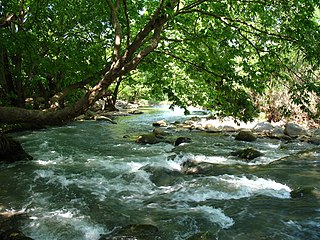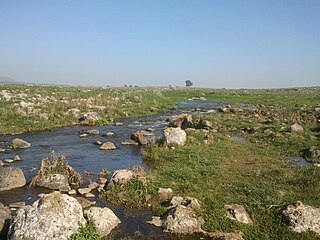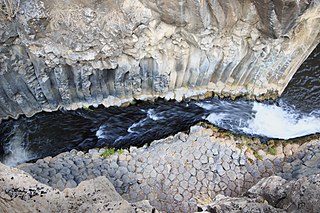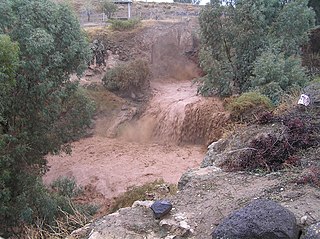Related Research Articles

The Jordan River or River Jordan, also known as Nahr Al-Sharieat, is a 251-kilometre-long (156 mi) river in the Middle East that flows roughly north to south through the Sea of Galilee and on to the Dead Sea. Jordan and the Golan Heights border the river to the east, while Israel and the occupied West Bank lie to its west. Both Jordan and the West Bank derive their names in relation to the river.

Brook of Egypt is the name used in some English translations of the Bible for the Hebrew נַחַל מִצְרַיִם, naḥal mizraim, a river (bed) forming the southernmost border of the Land of Israel. A number of scholars in the past identified it with Wadi el-Arish, an epiphemeral river flowing into the Mediterranean sea near the Egyptian city of Arish, while other scholars, including Israeli archaeologist Nadav Na'aman and the Italian Mario Liverani believe that the Besor stream, just to the south of Gaza, is the "Brook of Egypt" referenced in the Bible. A related phrase is nahar mizraim, used in Genesis 15:18.

Cherith, Kerith, or sometimes Chorath, is the name of a wadi, or intermittent seasonal stream mentioned in the Hebrew Bible. The prophet Elijah hid himself on the banks of the Cherith and was fed by ravens during the early part of the three years' drought which he announced to King Ahab.

The Yarmuk River is the largest tributary of the Jordan River. It runs in Jordan, Syria and Israel, and drains much of the Hauran plateau. Its main tributaries are the wadis of 'Allan and Ruqqad from the north, Ehreir and Zeizun from the east. Although the Yarmuk is narrow and shallow throughout its course, at its mouth it is nearly as wide as the Jordan, measuring thirty feet in breadth and five in depth. The once celebrated Matthew Bridge used to cross the Yarmuk at its confluence with the Jordan.

The Hasbani or Snir Stream, is the major tributary of the Jordan River. Native people in the mid-19th century knew the Hasbani as the Upper Jordan River.

Wadi Gaza and Besor Stream are parts of a river system in the Gaza Strip and Negev region of Palestine and Israel.

Wadi Qelt, in Hebrew Nahal Prat, formerly Naḥal Faran, is a valley, riverine gulch or stream in the West Bank, originating near Jerusalem and running into the Jordan River near Jericho, shortly before it flows into the Dead Sea.

Eli-ad is an Israeli settlement organized as a moshav in the southern Golan Heights. It falls under the jurisdiction of Golan Regional Council and in 2022 had a population of 496.

The Yarmukian culture was a Pottery Neolithic A (PNA) culture of the ancient Levant. It was the first culture in prehistoric Syria and one of the oldest in the Levant to make use of pottery. The Yarmukian derives its name from the Yarmuk River, which flows near its type site of Sha'ar HaGolan, near Kibbutz Sha'ar HaGolan at the foot of the Golan Heights. This culture existed alongside the Lodian, or Jericho IX culture and the Nizzanim culture to the south.

Nahal Amud, also known as the Wadi al-Amud, is a stream in the Upper Galilee region of Israel that flows into the Sea of Galilee.

Nahal Tavor, lit.Tabor Stream, is an intermittent stream in the Lower Galilee, Israel.

Poleg is a stream in the Sharon plain in Israel that empties into the Mediterranean Sea between Netanya and the Wingate Institute.

The Daliyot River is a river in the Golan Heights. It flows from the Golan Heights plateau, through the Gamla Nature Reserve and down the western slopes of the Heights, and into the Sea of Galilee.

Wadi Auja, also spelled Ouja, known in Hebrew as Nahal Yitav is a valley or stream, in the West Bank, originating near the Ein Samia spring and flowing to Al-Auja near Jericho before it runs into the Jordan River.

The Yehudiya Reserve is a nature reserve in the central Golan Heights. With the area of 134 sq. km, it is the largest reserve in the Golans. The height differential of its landscape - from 200 meters below the sea level to 600 meters above - provides for high waterfalls. It is named after the ancient village of Yehudiya, one of many archaeological sites located within the reserve. Due to the varied scenery of streams, gorges with waterfalls, woodlands, rich wildlife, and volcanic basalt landscape it is a popular tourist destination in Israel.

The Meshushim Stream is part of the Yehudiya Forest Nature Reserve in the Golan Heights. 35 km long, it starts from the foothills of Mount Avital and discharges via the Bethsaida Valley into the Sea of Galilee.

The Bethsaida Valley, Arabic: Buq'at al-Butayhah, is a valley by the northeast shores of the Sea of Galilee at the steep foothills of the central Golan Heights.

The Dishon Stream is an intermittent stream/wadi in Upper Galilee, Israel. It is 26 kilometers long, starts on the eastern slope of Mount Meron and drains into the Jordan River in the area of the drained Hula Lake. It is one of the largest streams in East Upper Galilee. Its name is a modification of the name of the depopulated Palestinian village of Dayshum.

The Harod Stream Hebrew: נחל חרוד, romanized: Nahal Harod, Arabic: نهر جالود, romanized: Wadi Jalud is a stream in Israel that flows west to east, from the Givat HaMoreh area via the Harod Valley and Beit She'an Valley into the Jordan River, about two kilometres (1.2 mi) north of Ma'oz Haim. It is the main drainage route of the Harod Valley
Fakhura or Fakhoura may refer to:
References
- Rand McNally, The New International Atlas, 1993.
- GEOnet Names Server